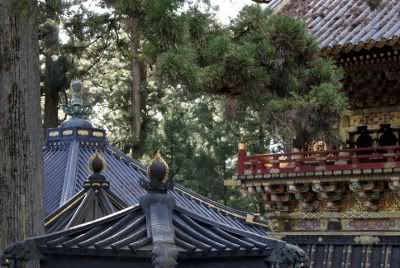
Today we took the train north to Nikko to see the World Heritage complex of Buddhist shrines and temples, which are nestled at the top of a hill within a thick forest of pine trees. I hadn't really heard of Nikko so didn't know what to expect, and so while the well-informed tourists rushed from carvings of sleeping cats to frescoes of wise monkeys to paintings of roaring dragons, we happily ambled around taking everything in, from the sheer scale of the buildings to the tiny carvings that gilded their sides.
First was Rinno-ji Sanbatsu, where three giant golden gods were hiding round the back, all the more amazing for being 1,244 years old, although the thousand-armed goddess of mercy was probably a few hundred arms short. We then entered the shrine complex of Tosho-gu which is probably the most famous and (in modern terms) Tomb Raidery, built on several levels up into the hillside and festooned with ancient pine trees. We found about a billion things to take photographs of here, and despite the influx of tourists it was a very pleasant place to be.
I still don't know much about Buddhist traditions, and while trying to enter one room to see the roaring dragon it turned out I was taking my shoes off in the wrong place, next to the 'please remove your shoes' sign. I don't think much of any religion whose main tenet is that you take off your shoes before you reach the sign telling you to take off your shoes. The roaring dragon was also a disappointment; the guidebook reported that a priest would clap his hands to demonstrate how the dragon could roar. From the spectacle that took place, I conclude that dragons briefly roar by gurgling quietly in a high-pitched echo.

After the stunning complex of Tosho-gu, it was perhaps a shame we next came to Futarasan shrine, such was the contrast: on the one hand, a series of immaculate buildings anointed with spectacular carvings; on the other: a couple of lean-to buildings with a spinning plate of plastic cakes, and a hoopla game made from rope.
As we approached the last of the temples – Rinno-ji Taiyuin – Paul read from the guidebook that it contains the mausoleum of the third Shogun. “What's a Shogun?” I wondered out loud. “Shogun was a television mini-series starring Richard Chamberlain,” Paul explained patiently, hiding his disgust at my ignorance.
On the way back to the railway station we passed Nikko's most famous landmark, the red lacquered Shin-kyo bridge, which legend has it marks the site where the Buddhist priest Shado Shonin crossed the river with the assistance of two generous snakes. Although a major tourist attraction, it turns out the bridge is now absolutely surrounded by modern roads and traffic and there is only one nice angle from which it can be photographed (needless to say, the angle used all of the guidebooks - whose side are they on?):

Although you can pay to go on the bridge (we did not), you only get to walk on a scaffold walkway built on top of the bridge and cannot anyway exit at the other side. The guidebook also reports that the original bridge was recently destroyed, and so the bridge is only a 2005 reconstruction (complete with steel supports). This was a slight disappointment.
We took the train home to Asakusa for dinner. After searching in vain for a recommended tempura restaurant opposite the Dembo-in shrine, we ended up at one on the seventh floor of the nearby Matsuya Department store. The Japanese seem to be very fond of carbohydrates, as several tempura options came in a set meal with separate bowls of white rice, udon noodles, wheat noodles and teppan noodles. This is possibly more side dishes than one requires. We opted for a simple tempura, served only with rice and teppan noodles.
There is a traditional conversation-starter where friends ask which cuisine you would happily only eat for the rest of your life, and I've always thought fondly of sushi, sashimi and noodles and gone for Japanese. This evening, however, we decided that we may already be reaching the point where just a little bit of non-Japanese food each day will help refine our appetites. Lovely as their simple approach to cooking is, most meals use the same set of ingredients: umami-rich miso and soy sauce, spring onions, pickled vegetables and the ubiquitous bowl of rice. It tends to prove rather samey, involves very few vegetables and also a poor balance between protein and refined white carbs. Tomorrow we'll try something western and I really won't miss the rice.




No comments:
Post a Comment